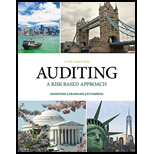
Auditing: A Risk Based-Approach (MindTap Course List)
11th Edition
ISBN: 9781337619455
Author: Karla M Johnstone, Audrey A. Gramling, Larry E. Rittenberg
Publisher: Cengage Learning
expand_more
expand_more
format_list_bulleted
Question
Chapter 5, Problem 19RQSC
To determine
Introduction : The objective of this analysis is to understand how an auditor carries out a material misstatement assessment through an analogy while identifying the potential risks and the risk levels and the auditor’s responsibility in doing so.
Understanding the risk of material misstatement is considered to be an important factor in auditing in identifying the potential risks.
Expert Solution & Answer
Want to see the full answer?
Check out a sample textbook solution
Students have asked these similar questions
Please explain the solution to this financial accounting problem with accurate principles.
I need guidance with this financial accounting problem using the right financial principles.
Can you explain this general accounting question using accurate calculation methods?
Chapter 5 Solutions
Auditing: A Risk Based-Approach (MindTap Course List)
Ch. 5 - Prob. 1CYBKCh. 5 - Prob. 2CYBKCh. 5 - Prob. 3CYBKCh. 5 - Prob. 4CYBKCh. 5 - Prob. 5CYBKCh. 5 - Prob. 6CYBKCh. 5 - Prob. 7CYBKCh. 5 - Prob. 8CYBKCh. 5 - Prob. 9CYBKCh. 5 - Prob. 10CYBK
Ch. 5 - Prob. 11CYBKCh. 5 - Prob. 12CYBKCh. 5 - Prob. 13CYBKCh. 5 - Prob. 14CYBKCh. 5 - Prob. 15CYBKCh. 5 - Which of the following accounts would not be...Ch. 5 - Prob. 17CYBKCh. 5 - Prob. 18CYBKCh. 5 - Prob. 19CYBKCh. 5 - Which management assertion is usually most...Ch. 5 - Prob. 21CYBKCh. 5 - Prob. 22CYBKCh. 5 - Prob. 23CYBKCh. 5 - Prob. 24CYBKCh. 5 - Prob. 25CYBKCh. 5 - Prob. 26CYBKCh. 5 - Prob. 27CYBKCh. 5 - Prob. 28CYBKCh. 5 - Prob. 29CYBKCh. 5 - Prob. 30CYBKCh. 5 - Prob. 31CYBKCh. 5 - Prob. 32CYBKCh. 5 - Prob. 33CYBKCh. 5 - Prob. 34CYBKCh. 5 - Prob. 35CYBKCh. 5 - Prob. 36CYBKCh. 5 - Prob. 37CYBKCh. 5 - Prob. 38CYBKCh. 5 - Prob. 39CYBKCh. 5 - Prob. 40CYBKCh. 5 - Prob. 41CYBKCh. 5 - Prob. 42CYBKCh. 5 - Prob. 43CYBKCh. 5 - Prob. 44CYBKCh. 5 - Prob. 45CYBKCh. 5 - Prob. 46CYBKCh. 5 - Prob. 47CYBKCh. 5 - Prob. 48CYBKCh. 5 - Prob. 1RQSCCh. 5 - Prob. 2RQSCCh. 5 - Prob. 3RQSCCh. 5 - Prob. 4RQSCCh. 5 - Prob. 5RQSCCh. 5 - Prob. 6RQSCCh. 5 - Professional guidance indicates that the auditor...Ch. 5 - Identify the accounts associated with the...Ch. 5 - Assume that an organization asserts that it has...Ch. 5 - Prob. 10RQSCCh. 5 - Prob. 11RQSCCh. 5 - Prob. 12RQSCCh. 5 - Prob. 13RQSCCh. 5 - List factors that might affect an audit firm’s...Ch. 5 - Prob. 15RQSCCh. 5 - Prob. 16RQSCCh. 5 - Prob. 17RQSCCh. 5 - Prob. 18RQSCCh. 5 - Prob. 19RQSCCh. 5 - Prob. 20RQSCCh. 5 - Prob. 21RQSCCh. 5 - Prob. 22RQSCCh. 5 - Prob. 23RQSCCh. 5 - Prob. 24RQSCCh. 5 - Prob. 25RQSCCh. 5 - Prob. 26RQSCCh. 5 - Prob. 27RQSCCh. 5 - Prob. 28RQSCCh. 5 - Prob. 29RQSCCh. 5 - Prob. 30RQSCCh. 5 - Prob. 32RQSCCh. 5 - Prob. 33RQSCCh. 5 - Prob. 34RQSCCh. 5 - Prob. 35RQSCCh. 5 - Prob. 36RQSCCh. 5 - Prob. 37RQSCCh. 5 - Prob. 38RQSCCh. 5 - Prob. 39RQSCCh. 5 - Prob. 40RQSCCh. 5 - Prob. 42RQSCCh. 5 - Prob. 43RQSCCh. 5 - Prob. 44FF
Knowledge Booster
Similar questions
- Can you explain this general accounting question using accurate calculation methods?arrow_forwardPlease provide the correct answer to this general accounting problem using accurate calculations.arrow_forwardInnovations Inc. had a $38,000 beginning inventory and a $45,000 ending inventory. Net sales were $215,000; purchases were $110,000; purchase returns and allowances were $5,000; and freight-in was $9,000. Cost of goods sold for the period is $107,000. What is Innovations Inc.'s gross profit percentage?arrow_forward
- What is the total amount of product costs incurred to make 11,400 unitsarrow_forwardProvide correct answer this general accounting questionarrow_forwardLuma Co. had the following transactions in 2020: Sales of $5,200 on account . Collected $2,200 for services to be performed in 2021 . Paid $1,500 cash in salaries Bought event tickets for $300 in December for 2021 What is Luma's 2020 net income using cash- basis accounting?arrow_forward
arrow_back_ios
SEE MORE QUESTIONS
arrow_forward_ios
Recommended textbooks for you
 Auditing: A Risk Based-Approach (MindTap Course L...AccountingISBN:9781337619455Author:Karla M Johnstone, Audrey A. Gramling, Larry E. RittenbergPublisher:Cengage Learning
Auditing: A Risk Based-Approach (MindTap Course L...AccountingISBN:9781337619455Author:Karla M Johnstone, Audrey A. Gramling, Larry E. RittenbergPublisher:Cengage Learning Auditing: A Risk Based-Approach to Conducting a Q...AccountingISBN:9781305080577Author:Karla M Johnstone, Audrey A. Gramling, Larry E. RittenbergPublisher:South-Western College Pub
Auditing: A Risk Based-Approach to Conducting a Q...AccountingISBN:9781305080577Author:Karla M Johnstone, Audrey A. Gramling, Larry E. RittenbergPublisher:South-Western College Pub

Auditing: A Risk Based-Approach (MindTap Course L...
Accounting
ISBN:9781337619455
Author:Karla M Johnstone, Audrey A. Gramling, Larry E. Rittenberg
Publisher:Cengage Learning

Auditing: A Risk Based-Approach to Conducting a Q...
Accounting
ISBN:9781305080577
Author:Karla M Johnstone, Audrey A. Gramling, Larry E. Rittenberg
Publisher:South-Western College Pub
